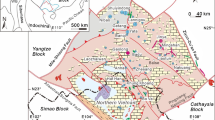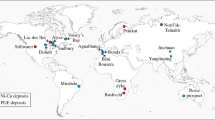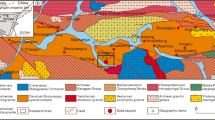Abstract
A comparative in situ LA-ICP MS trace-element study on pyrite from three different, variably auriferous, Archaean to Palaeoproterozoic palaeoplacer deposits in the Ouro Fino Syncline (Quadrilátero Ferrífero; Brazil), the Elliot Lake area north of Lake Huron (SE Canada) and several deposits within the Witwatersrand Basin (South Africa) revealed systematic differences between morphologically different pyrite types and between the various palaeoplacer deposits. Especially the Ni and Au concentrations as well as Co/Ni and Mo/Ni ratios were found to be systematically different in detrital compact, detrital porous and post-sedimentary/hydrothermal pyrite grains from different source areas. High Co/Ni ratios and low Au concentrations are typical of post-sedimentary pyrite, which is hydrothermal in origin. In contrast, relatively low Co/Ni ratios and high Au contents characterise detrital porous banded and concentric pyrite grains (Au > 1 ppm), which are syn-sedimentary in origin. In the Elliot Lake area and the Witwatersrand Basin, detrital compact rounded pyrite is characterised by high Co/Ni ratios, which is in agreement with derivation from a hydrothermal source. Low Au concentrations in this pyrite type support the contention of the gold and the pyrite in these deposits coming from different source rocks. In contrast, derivation from an originally diagenetic pyrite is suggested for the detrital compact pyrite in the Ouro Fino Syncline because of low to intermediate Co/Ni ratios. High Au contents may indicate a genetic relationship between pyrite and gold there. Systematic differences exist between the three areas with respect to Au, Ni, Co, Mo and Cu distributions in detrital pyrite, which reflects differences in the provenance. A predominantly mafic/ultramafic source is indicated for the Ouro Fino, a felsic source for the Elliot Lake, and a mixed felsic–mafic provenance for the Witwatersrand pyrite populations. Independently of pyrite type, the higher Au endowment of the studied Witwatersrand and Ouro Fino conglomerates are also reflected by an overall higher Au concentration in the respective pyrite grains compared to the relatively Au-poor samples from Elliot Lake. In general, a strong positive correlation between Au and Pb levels in the various pyrite grains is noted. Analogous to Pb, which is well known for not being easily accommodated in the pyrite crystal lattice but occurring as discrete PbS phases, Au is considered to be present mainly in the form of discrete Au phases in minute pores and interstices of the pyrite grains rather than within the pyrite lattice.











Similar content being viewed by others
References
Alkmim FF, Marshak S (1998) Transamazonian Orogeny in the Southern São Francisco Craton Region, Minas Gerais, Brazil: evidence for Paleoproterozoic collision and collapse in the Quadrilátero Ferrífero. Precambrian Research 90:29–58
Barnicoat AC, Henderson IHC, Knipe JR, Yardley BWD, Napier RW, Fox NPC, Kenyon AK, Muntingh DJ, Strydon D, Winkler KS, Lawrence SR, Conford C (1997) Hydrothermal gold mineralization in the Witwatersrand Basin. Nature 386:820–824
Barton ES, Hallbauer DK (1996) Trace-element and U-Pb isotope compositions of pyrite types in the Proterozoic Black Reef, Transvaal Sequence, South Africa: implications on genesis and age. Chemical Geology 133:173–199
Boiron MC, Moissette A, Cathelineau M, Banks D, Monnin C, Dubessy J (1999) Detailed determination of palaeofluid chemistry: an integrated study of sulphate-volatile rich brines and aquo-carbonic fluids in quartz veins from Ouro Fino (Brazil). Chemical Geology 154:179–192
Bralia A, Sabatini G, Troja F (1979) A revaluation of the Co/Ni ratio in pyrite as geochemical tool in ore genesis problems. Mineralium Deposita 14:353–374
Brandl G, Cloete M, Anhaeusser CR (2006) Archaean greenstone belts. In: Johnson MR, Anhaeusser CR, Thomas RJ (eds) The geology of South Africa. Geological Society of South Africa and Council for Geoscience, Johannesburg, pp 9–56
Chemale F, Rosière CA, Endo I (1994) The tectonic evolution of the Quadrilátero Ferrífero, Minas Gerais, Brazil. Precambrian Research 65:22–54
Clark C, Grguric B, Schmidt Mumm A (2004) Genetic implications of pyrite chemistry from the Palaeoproterozoic Olary Domain and overlying Neoproterozoic Adelaidean sequences, northeastern South Australia. Ore Geology Review 25:237–257
Craig JR, Vokes FM, Solberg TN (1998) Pyrite: physical and chemical textures. Mineralium Deposita 34:82–101
Dorr JVN II (1969) Physiographic, stratigraphic, and structural development of the Quadrilátero Ferrífero, Minas Gerais, Brazil. U.S.G.S. Professional Paper 641A, 110 pp
England GL, Rasmussen B, Krapez B, Groves DI (2002) Palaeoenvironmental significance of rounded pyrite in siliciclastic sequences of the Late Archaean Witwatersrand Basin: oxygen-deficient atmosphere or hydrothermal alteration? Sedimentology 49:1133–1156
Feather C, Koen GM (1975) The mineralogy of the Witwatersrand reefs. Minerals Science and Engineering 7:189–224
Fleet ME (1998) Detrital pyrite in Witwatersrand gold reefs: X-ray diffraction evidence and implications for atmospheric evolution. Terra Nova 10:302–306
Fralick PW, Miall AD (1989) Sedimentology of the Lower Huronian Supergroup (Early Proterozoic), Elliot Lake area, Ontario, Canada. Sedimentary Geology 63:127–153
Frimmel HE (2005) Archean atmospheric evolution: evidence from the Witwatersrand gold fields, South Africa. Earth-Science Reviews 70:1–46
Frimmel HE (2008) Earth's continental crustal gold endowment. Earth and Planetary Science Letters 267:45–55
Frimmel HE, Gartz VH (1997) Witwatersrand gold particle chemistry matches model of metamorphosed, hydrothermally altered placer deposits. Mineralium Deposita 32:523–530
Frimmel HE, Minter WEL (2002) Recent Developments Concerning the Geological History and Genesis of the Witwatersrand Gold Deposits, South Africa. Society of Economic Geologists Special Publication 9:17–45
Frimmel HE, Le Roex AP, Knight J, Minter WEL (1993) A case study of the postdepositional alteration of the Witwatersrand Basal Reef gold placer. Economic Geology 88:249–265
Frimmel HE, Hallbauer DK, Gartz VH (1999) Gold mobilizing fluids in the Witwatersrand Basin: composition and possible sources. Mineralogy and Petrology 66:55–81
Frimmel HE, Groves DI, Kirk J, Ruiz J, Chesley J, Minter WEL (2005) The formation and preservation of the Witwatersrand goldfields, the largest gold province in the world. In: Hedenquist JW, Thompson JFH, Goldfarb RJ, Richards JP (eds) Economic geology one hundredth anniversary volume. Society of Economic Geologists, Littleton, pp 769–797
Frimmel HE, Zeh A, Lehrmann B, Hallbauer DK, Frank W (2009) Geochemical and geochronological constraints on the nature of the immediate basement beneath the Mesoarchaean auriferous Witwatersrand Basin, South Africa. Journal of Petrology. doi:10.1093/petrology/egp073
Gartz VH, Frimmel HE (1999) Complex metasomatism of an Archean placer in the Witwatersrand Basin, South Africa: the Ventersdorp Contact Reef - A Hydrothermal Aquifer? Economic Geology 94:689–706
Garayp E, Minter WEL, Renger FE, Siegers A (1991) Moeda placer gold deposits in the Ouro Fino Syncline, Quadrilátero Ferrífero, Brazil. In: Ladeira EA (ed) Proceedings of Brazil gold '91; the economics, geology, geochemistry and genesis of gold deposits, pp 601–608
Grandstaff DE (1980) Origin of uraniferous conglomerates at Elliot Lake, Canada and Witwatersrand, South Africa: implications for oxygen in the Precambrian atmosphere. Precambrian Research 13:1–26
Hallbauer DK (1986) The mineralogy and geochemistry of Witwatersrand pyrite, gold, uranium, and carbonaceous matter. In: Anhaeusser CR, Maske S (eds) Mineral deposits of Southern Africa. Geological Society of South Africa, Johannesburg, pp 731–752
Hartmann LA, Ebdo I, Suita MDF, Santos JOS, Frantz JC, Carneiro MA, McNaughton NJ, Barley ME (2006) Provenance and age delimitation of Quadrilátero Ferrífero sandstones based on zircon U-Pb isotopes. Journal of South American Earth Sciences 20:273–285
Hofmann A, Bekker A, Rouxel O, Rumble D, Master S (2009) Multiple sulphur and iron isotope composition of detrital pyrite in Archaean sedimentary rocks: a new tool for provenance analysis. Earth and Planetary Science Letters 286:436–445
Huerta-Diaz MA, Morse JW (1992) Pyritization of trace metals in anoxic marine sediments. Geochimica et Cosmochimica Acta 56:2681–2702
James CS, Minter WEL (1999) Experimental flume study of the deposition of heavy minerals in a simulated Witwatersrand sandstone unconformity. Economic Geology 94:671–688
Kimberley MM, Tanaka RT, Farr MR (1980) Composition of Middle Precambrian uraniferous conglomerate in the Elliot Lake-Agnew Lake area of Canada. Precambrian Research 12:375–392
Kirk J, Ruiz J, Chesley J, Titley S, Walshe J (2001) A detrital model for the origin of gold and sulfides in the Witwatersrand basin based on Re–Os isotopes. Geochimica et Cosmochimica Acta 65:2149–2159
Kirk J, Ruiz J, Chesley J, Walshe J, England G (2002) A major Archean, gold- and crust-forming event in the Kaapvaal Craton, South Africa. Science 297:1856–1858
Kositcin N, Krapez B (2004) Relationship between detrital zircon age-spectra and the tectonic evolution of the Late Archaean Witwatersrand Basin, South Africa. Precambrian Research 129:141–168
Large RR, Danyushevsky L, Hollit C, Maslennikov V, Meffre S, Gilbert S, Bull S, Scott R, Emsbo P, Thomas H, Singh B, Foster J (2009) Gold and trace element zonation in pyrite using a laser imaging technique: implications for the timing of gold in orogenic and Carlin-style sediment-hosted deposits. Economic Geology 104:635–668
Lobato LM, Ribeiro-Rodrigues LC, Zucchetti M, Noce CM, Baltazar OF, da Silva LC, Pinto CP (2001a) Brazil’s premier gold province. Part I: the tectonic, magmatic and structural setting of the Archean Rio das Velhas greenstone belt, Quadrilátero Ferrífero. Mineralium Deposita 36:228–249
Lobato LM, Ribeiro-Rodrigues LC, Vieira FWR (2001b) Brazil’s premier gold province. Part II: geology and genesis of gold deposits in the Archean Rio das Velhas greenstone belt, Quadrilátero Ferrífero. Mineralium Deposita 36:249–277
McCarthy TS (2006) The Witwatersrand Supergroup. In: Johnson MR, Anhaeusser CR, Thomas RJ (eds) The geology of South Africa. Geological Society of South Africa, Johannesburg, pp 155–186
McLean PJ, Fleet ME (1989) Detrital pyrite in the Witwatersrand gold fields of South Africa: evidence from truncated growth banding. Economic Geology 84:2008–2011
Minter WEL, Feather CE, Glathaar CW (1988) Sedimentological and mineralogical aspects of the newly discovered Witwatersrand placer deposit that reflects Proterozoic weathering, Welkom gold field, South Africa. Economic Geology 83:481–491
Minter WEL, Renger FE, Siegers A (1990) Early Proterozoic gold placers of the Moeda Formation within the Gandarela Syncline, Minas Gerais, Brazil. Economic Geology 85:943–951
Minter WEL, Goedhart ML, Knight J, Frimmel HE (1993) Morphology of Witwatersrand gold grains from the Basal Reef: evidence for their detrital origin. Economic Geology 88:237–248
Morse JW, Luther GW III (1999) Chemical influences on trace metal-sulfide interactions in anoxic sediments. Geochimica et Cosmochimica Acta 63:3373–3378
Mossman DJ, Minter WEL, Dutkiewicz A, Hallbauer DK, George SC, Hennigh Q, Reimer TO, Horscroft FD (2008) The indigenous origin of Witwatersrand "carbon". Precambrian Research 164:173–186
Phillips GN, Law JDM (1994) Metamorphism of the Witwatersrand gold fields: a review. Ore Geology Reviews 9:1–31
Phillips GN, Myers RE (1989) Witwatersrand gold field. Part II. An origin for Witwatersrand gold during metamorphism and associated alteration. In: Keays RR, Ramsay WRH, Groves DI (eds) The geology of gold deposits: the perspective in 1988. Society of Economic Geologists, Littleton, pp 598–608
Poujol M, Robb LJ, Anhaeusser CR, Gericke B (2003) A review of geochronological constraints on the evolution of the Kaapvaal Craton, South Africa. Precambrian Research 127:181–213
Przybyłowicz WJ, Prozesky VM, Meyer FM (1995) True elemental imaging of pyrites from Witwatersrand reefs. Nuclear Instruments and Methods in Physics Research Section B 104:450–455
Ramdohr P (1958) New observations on the ores of the Witwatersrand in South Africa and their genetic significance. Transactions of the Geological Society of South Africa (Annexure) 61:1–50
Raymond OL (1996) Pyrite composition and ore genesis in the Prince Lyell copper deposit, Mt Lyell mineral field, western Tasmania, Australia. Ore Geology Reviews 10:231–250
Reimold WU, Przybyłowicz WJ, Gibson RL (2004) Quantitative major and trace elemental mapping by PIXE of concretionary pyrite from the Witwatersrand Basin, South Africa. X-Ray Spectrometry 33:189–203
Robb LJ, Brandl G, Anhaeusser CR, Poujol M (2006) Archaean granitoid intrusions. In: Johnson MR, Anhaeusser CR, Thomas RJ (eds) The geology of South Africa. Geological Society of South Africa and Council for Geoscience, Johannesburg, pp 57–94
Roberts FI (1982) Trace element geochemistry of pyrite: a useful guide to the occurrence of sulfide base metal mineralization. Journal of Geochemical Exploration 17:49–62
Robinson A, Spooner ETC (1982) Source of the detrital component of uraniferous conglomerate, Quirke ore zone, Elliot Lake, Ontario, Canada. Nature 299:622–624
Roscoe SM (1969) Huronian rocks and uraniferous conglomerates in the Canadian Shield. Geological Survey of Canada, Paper 68–40:205
Roscoe SM (1973) The Huronian Supergroup, a Paleoaphebian succession showing evidence of atmospheric evolution. In: Young GM (ed) Geological association of Canada 12:31–47, Special Paper
Silva AM, McCafferty A, Pires ACB, Ribeiro-Rodrigues LC (2000) Predictive geophysical model for gold mineralization in the Quadrilátero Ferrífero, Brazil: the case of Cuiabá Mine. Revista Brasileira de Geociências 30:543–546
Spier CA, de Oliveira SMB, Sial AN, Rios FJ (2007) Geochemistry and genesis of the banded iron formations of the Cauê Formation, Quadrilátero Ferrífero, Minas Gerais, Brazil. Precambrian Research 152:170–206
Sutton SJ, Maynard JB (1993) Petrology, mineralogy, and geochemistry of sandstones of the lower Huronian Matinenda Formation: resemblance to underlying basement rocks. Canadian Journal of Earth Sciences 30:1209–1223
Tribovillard N, Algeo TJ, Lyons T, Riboulleau A (2006) Trace metals as paleoredox and paleoproductivity proxies: An update. Chemical Geology 232:12–32
van Achterbergh E, Ryan CG, Griffin WL (2000) GLITTER: on-line interactive data reduction for the Laser Ablation ICP-MS Microprobe. Ninth Annual V. M. Goldschmidt Conference, August 22–27, 1999, Cambridge, Massachusetts, abstract no. 7215
Wohlgemuth-Ueberwasser CC, Ballhaus C, Berndt J, Stotter nee Paliulionyte V, Meisel T (2007) Synthesis of PGE sulfide standards for laser ablation inductively coupled plasma mass spectrometry (LA-ICP-MS). Contributions to Mineralogy and Petrology 154:607–617
Young GM, Long DGF, Fedo CM, Nesbitt HW (2001) Paleoproterozoic Huronian basin: product of a Wilson cycle punctuated by glaciations and a meteorite impact. Sedimentary Geology 141–142:233–254
Zucchetti M, Lobato LM, Baars JF (2000) Volcanic and volcaniclastic features in Archean rocks and their tectonic environments, Rio das Velhas greenstone belt, Quadrilátero Ferrífero, MG – Brazil. Revista Brasileira de Geociências 30:388–392
Acknowledgements
A. R. Cabral, Y. Morishita and B. Lehmann are thanked for their constructive critical reviews. R. Klemd kindly provided access to the analytical facilities in Erlangen. Financial support from the German Research Foundation (Grant FR 2183/3-2) is gratefully acknowledged. This is a contribution to IGCP540.
Author information
Authors and Affiliations
Corresponding author
Additional information
Editorial handling: B. Lehmann
Electronic supplementary material
Supplemental Figure 1
Co, Mo, Cu, Ag versus Ni contents for different pyrite types from the analysed reefs of the Witwatersrand Basin (GIF 108 kb)
Rights and permissions
About this article
Cite this article
Koglin, N., Frimmel, H.E., Lawrie Minter, W.E. et al. Trace-element characteristics of different pyrite types in Mesoarchaean to Palaeoproterozoic placer deposits. Miner Deposita 45, 259–280 (2010). https://doi.org/10.1007/s00126-009-0272-0
Received:
Accepted:
Published:
Issue Date:
DOI: https://doi.org/10.1007/s00126-009-0272-0




